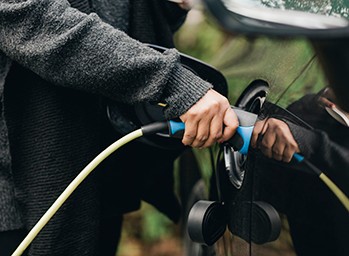
Considering EVs? Consider Them Faster.
NI’s test solutions help EV automakers meet production targets, maximize quality and performance, minimize risks of delays or recalls, and deliver innovation to the road faster.

When the time came to replace my 10-year-old sedan in 2015, I knew I wouldn’t be purchasing another internal combustion engine vehicle. The idea of buying a gasoline car felt akin to using a typewriter for work: old-fashioned. This was not a widely held opinion then, or even now. Yet, it’s remarkable to observe the shifting sentiment since that time and consider the implications for consumers and the automotive industry.
After purchasing my first EV, I was met with concerns from even my tech-savviest friends and colleagues: “How will you charge it? Can you take road trips? How long will the battery last?” While these concerns were not entirely unfounded, they demonstrated how far EVs had to go before becoming mainstream.
My family and I quickly fell in love with the EV lifestyle. We woke up every morning to a fully charged car—no more trying to squeeze in a stop at the gas station. Cross-country road trips were actually less stressful in our EV—they became easier to plan since we mapped out charging stops beforehand and knew exactly where we’d be stopping.
Most of all, it felt good to be a part of a movement we believed in, but the instant torque of an electric motor and the handling of a car with such a low center-of-gravity didn’t hurt either. Our first EV was joined by a second after only a year, making our transition to a fully electric family complete.
Fast forward to 2022: this year’s Super Bowl had no fewer than four ads for new all-electric vehicles, marking a major milestone in the ongoing transition. We are at the beginning of a massive S-curve, the likes of which the industry hasn’t seen in decades as EVs become more commonplace and sought after. Conservative estimates are forecasting that the industry will manufacture as many as 12M new battery electric vehicles (BEVs) in 2025, requiring a global capacity of well over 1,300 GWh.
As a consumer, I’m thrilled by my experience and the feeling of contributing to a more sustainable future. As someone who has spent their entire career in test and measurement, I’m fascinated by the technical challenges that OEMs and the supply chain face.
The battery is the core element of a BEV: it defines the range, performance, and cost and profitability. Batteries also have direct implications on safety: most BEVs are heavy and have a very low center of gravity, making them very safe thanks to their unwillingness to roll over. The absence of a massive engine and transmission in front of the passenger makes the deadliest of collisions, high-speed front-end collisions, far more survivable. However, batteries pose their own set of concerns regarding thermal events that could lead to expensive recalls or even fires.
It’s for these reasons that few components so acutely illustrate the balancing act of manufacturing throughput and testing coverage. The average cost of a battery pack was $137/kWh in 2021, and it’s said that the $100/kWh milestone will mark the key price point at which a BEV is less expensive than a comparable gasoline car. Though for some vehicle categories, ownership costs are already tilted in favor of BEVs.
Trending headlines continue to reinforce the ongoing investments into standing up new facilities by both OEMs and cell suppliers. The formation and aging of a cell takes about two weeks, making it one of the costliest and resource-intensive aspects of battery production. Assembly of the modules and packs is more straightforward, but the implications and cost associated with reworking failed products or servicing field failures can be massive.
Successfully scaling battery operations will require novel approaches to test and manufacturing that focus on the following:
Finally, part of what makes this time so exciting is that, in many ways, scaling EV manufacturing is still a new frontier of innovation and technology. I’m excited by the role NI and our solutions are playing in such a pivotal moment—we're making these novel solutions more available and accessible for high volume manufacturing, and we’re genuinely excited for the role our products are playing in accelerating the advent of more sustainable transportation.